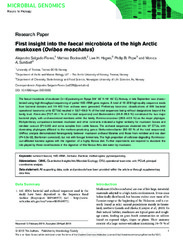| dc.contributor.author | Salgado, Alejandro Flores | |
| dc.contributor.author | Bockwoldt, Mathias | |
| dc.contributor.author | Hagen, Live Heldal | |
| dc.contributor.author | Pope, Phillip | |
| dc.contributor.author | Sundset, Monica Alterskjær | |
| dc.date.accessioned | 2016-08-19T12:26:01Z | |
| dc.date.available | 2016-08-19T12:26:01Z | |
| dc.date.issued | 2016-07-11 | |
| dc.description.abstract | The faecal microbiota of muskoxen (n=3) pasturing on Ryøya (69° 33′ N 18° 43′ E), Norway, in late September was characterized using high-throughput sequencing of partial 16S rRNA gene regions. A total of 16 209 high-quality sequence reads from bacterial domains and 19 462 from archaea were generated. Preliminary taxonomic classifications of 806 bacterial operational taxonomic units (OTUs) resulted in 53.7–59.3 % of the total sequences being without designations beyond the family level. Firmicutes (70.7–81.1 % of the total sequences) and Bacteroidetes (16.8–25.3 %) constituted the two major bacterial phyla, with uncharacterized members within the family Ruminococcaceae (28.9–40.9 %) as the major phylotype. Multiple-library comparisons between muskoxen and other ruminants indicated a higher similarity for muskoxen faeces and reindeer caecum (P>0.05) and some samples from cattle faeces. The archaeal sequences clustered into 37 OTUs, with dominating phylotypes affiliated to the methane-producing genus Methanobrevibacter (80–92 % of the total sequences). UniFrac analysis demonstrated heterogeneity between muskoxen archaeal libraries and those from reindeer and roe deer (P=1.0e-02, Bonferroni corrected), but not with foregut fermenters. The high proportion of cellulose-degrading Ruminococcus-affiliated bacteria agrees with the ingestion of a highly fibrous diet. Further experiments are required to elucidate the role played by these novel bacteria in the digestion of this fibrous Artic diet eaten by muskoxen. | en_US |
| dc.description.sponsorship | Funding by UiT - The Arctic University of Tromsø, Norway. PBP was supported by a grant from the European Research Council (336355-MicroDE). | en_US |
| dc.description | Publisher's version, source <a href=http://doi.org/10.1099/mgen.0.000066>http://doi.org/10.1099/mgen.0.000066</a> | en_US |
| dc.identifier.citation | Microbial Genomics 2016 | en_US |
| dc.identifier.cristinID | FRIDAID 1358623 | |
| dc.identifier.doi | 10.1099/mgen.0.000066 | |
| dc.identifier.issn | 2057-5858 | |
| dc.identifier.uri | https://hdl.handle.net/10037/9520 | |
| dc.identifier.urn | URN:NBN:no-uit_munin_9076 | |
| dc.language.iso | eng | en_US |
| dc.publisher | Microbiology Society | en_US |
| dc.relation.projectID | EU: ERC-336355 | |
| dc.rights.accessRights | openAccess | |
| dc.subject | VDP::Matematikk og Naturvitenskap: 400::Zoologiske og botaniske fag: 480::Zoologisk anatomi: 481 | en_US |
| dc.subject | ruminant faeces | en_US |
| dc.subject | Bacteria | en_US |
| dc.subject | Archaea | en_US |
| dc.subject | pyrosequencing | en_US |
| dc.subject | 16S rRNA | en_US |
| dc.subject | methanogens | en_US |
| dc.title | A first insight into the fecal microbiota of the high Arctic muskoxen (Ovibos moschatus) | en_US |
| dc.type | Journal article | en_US |
| dc.type | Tidsskriftartikkel | no |


 English
English norsk
norsk